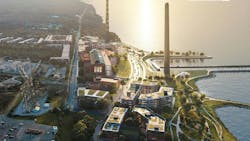Trends to watch shaping the future of ESG
We sat down with Gensler’s Climate Action & Sustainability Services Leaders, and Anthony Brower, Juliette Morgan, and Kirsten Ritchie to discuss trends shaping the future of environmental, social, and governance (ESG) and design strategies for climate action.
This blog first appeared as part of Gensler's Design Forecast blog series, looking at what’s next in 2023 and beyond.
ESG Interest from Clients
“Certifications are often the first thing people think of when ESG and design are mentioned in the same breath. They’re tangible, and they enable organizations to showcase their commitments. Where are you seeing the most interest from clients when it comes to ESG and certifications?”
Juliette Morgan: Among our clients, we are seeing the biggest jump in interest surrounding the ‘S’ in ESG, and what it means in design and delivery of space. The social aspect of ESG is less regulated and structured than carbon emissions, and it’s still unclear what precisely it will mean and how it should get reported. Some organizations focus on amenities for the people within a building, while others look for a broader sense of community and social inclusion. Additional considerations have expanded their definition to include strategies around employment creation with respect to equity and diversity. The answer for many will be some version of “all of the above,” but the specifics are still getting ironed out.
Challenges When Designing for ESG
“Let’s talk about the challenges you’re facing that you think we can overcome in the near term. What’s one hurdle that sometimes gets in the way of designing for ESG that we could fix within the next five years?”
Kirsten Ritchie: In the U.S., financing more socially inclusive projects is often the stickiest issue—particularly if you want to take something that is classified as office and convert it. But there is a recognition growing that this is a roadblock—and a roadblock we can overcome.
Juliette Morgan: It’s interesting, because from a U.S. perspective what Kirsten just mentioned is absolutely right. Yet in Europe, financing mixed-use buildings is bread and butter; we don’t even question how to invest in those structures. Within both contexts, I would add that there is now so much finance that has to comply with ESG reporting standards that it will start to drive what kinds of buildings become investable based on their environmental and social criteria. That’s going to be an incredibly potent driver of change.
Anthony Brower: To add to what Kirsten was saying for the U.S., it has been incredibly challenging for local municipalities to keep up with ESG for design and architecture. For example, there are several cities where if a solar canopy exceeds a certain percentage of a building’s roof area, you must count that solar canopy as part of the total building height. In turn, that means you may have to remove around eight feet of space from your floors to make the solar canopy work, and it ends up disincentivizing the opportunity to roll back some of your carbon emissions. There are many such cases where local building codes can get in the way of the actions we want to take, and we need to get more involved in reforming these codes.
Kirsten Ritchie: That’s right. I would add zoning to the conversation. Particularly in San Francisco, there are plenty of opportunities for Class B and C offices to introduce more mixed-use components, but older zoning requirements dictate that they must be single use. That has to change, and I’m confident that it will. There is going to be a lot of action and movement in that arena over the next decade.
Design Strategies Shaping ESG
“What are some of your favorite climate action design strategies for the coming years?”
Juliette Morgan: I’m already hearing clients ask about how to “rewild” their projects and add to the biodiversity of their areas. Europe is well on its way to creating completely regenerative systems, and emerging markets can leapfrog by learning from those strategies.
Anthony Brower: What people are clamoring for now are things that they can actually see in the built environment. There are so many unfortunate situations in which building operators will pour additional heating and cooling into a building with a leaky envelope—and the energy is just escaping and gets wasted. One of the more creative opportunities for us is to develop ways to make energy efficiency visible to people beyond just utility bills. It sounds wonky, but it’s about showing how much of a difference design can make in how a building operates every day, both for the bottom line and for the environment.
Kirsten Ritchie: There are a few I could list out, particularly with respect to office construction. There is a design debate emerging around how to align the interests of developers, tenants, commissioners, and investors regarding carbon reduction goals. Getting carbon down is everyone’s shared objective, but how that flows through to design can take many forms. Depending on the situation, we could reduce column density, get rid of basements, or employ cantilevered roof terraces to use less concrete. Design elements like this aren’t necessarily common today, but if we were going to read some tea leaves, those are the changes that would be in the design forecast.
How to Achieve ESG Goals
“Give us a mantra for the coming year—20 words or fewer. What’s the best advice you could give to a building owner, developer, or tenant thinking about how design can help them with their ESG goals?”
Anthony Brower: Prioritize local materials. Simply eliminating transportation saves the carbon associated with that step without having to get into the math.
Juliette Morgan: It’s morally right and design correct to prioritize retrofit over new build. If you have the opportunity, seriously consider that path.
Kirsten Ritchie: The entire business community—design firms and our clients—are still underperforming on carbon. Let’s own it and let’s do something about it.




